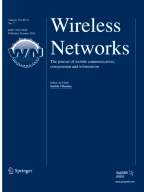Abstract
Wireless networked control systems (WNCS) are composed of spatially distributed sensors, actuators, and controllers communicating through wireless networks instead of conventional point-to-point wired connections. While WNCSs have a tremendous potential to improve the efficiency of many critical control systems, for instance, in building automation and process control, the systems are fundamentally constrained by the packet losses and the functional faults of the underlying wireless sensor and actuator networks. Understanding the interaction between wireless networks and control systems is essential to characterize the performance limitations of the critical control systems and optimize its wireless network resources. This paper presents an analytical framework for modeling the behavior of the control loop over lossy and faulty network. The control loop over wireless networks is modeled through a Markov chain taking into account sensing links, actuating links, and recovery mechanism to compensate the faulty nodes. By using this model, the novel performance metrics are mathematically derived and are evaluated through both theoretical analysis and simulation results. The performance evaluation shows the critical tradeoff between the average performance when the control loop is in the normal operation mode and the recovery performance when it is in the abnormal operating mode due to the faulty nodes.
Similar content being viewed by others
References
Sztipanovits, J., Koutsoukos, X., Karsai, G., Kottenstette, N., Antsaklis, P., Gupta, V., et al. (2012). Toward a science of cyber–physical system integration. Proceedings of the IEEE, 100(1), 2944.
Bello, O., & Zeadally, S. (2016). Intelligent device-to-device communication in the internet of things. IEEE Systems Journal, 10(3), 11721182.
Hespanha, J. P., Naghshtabrizi, P., & Xu, Y. (2007). A survey of recent results in networked control systems. Proceedings of the IEEE, 95(1), 138162.
Kim, K. D., & Kumar, P. R. (2012). Cyber physical systems: A perspective at the centennial. Proceedings of the IEEE, 100, 12871308.
Al-Dabbagh, A. W., & Chen, T. (2016). Design considerations for wireless networked control systems. IEEE Transactions on Industrial Electronics, 63, 5547–5557.
Petersen, S., & Carlsen, S. (2011). WirelessHART versus ISA100.11a: The format war hits the factory floor. IEEE Industrial Electronics Magazine, 5(4), 2334.
Bill, P., Kranich, M., & Chari, N. (2013). Fine mesh 802.11 wireless network connectivity. ABB, Technical report
Blaney, J. (2009). Wireless proves its value. Power Engineering, 113(2), 38.
Pister, K., Thubert, P., Systems, C., Dwars, S., & Phinney, T. (2009). Industrial routing requirements in low-power and lossy networks. IETF.
Bahramgiri, M., Hajiaghayi, M., & Mirrokni, V. S. (2006). Fault-tolerant and 3-dimensional distributed topology control algorithms in wireless multi-hop networks. Wireless Networks, 12(2), 179188.
Thallner, B., Moser, H., & Schmid, U. (2010). Topology control for fault-tolerant communication in wireless ad hoc networks. Wireless Networks, 16(2), 387404.
Saha, I., Sambasivan, L. K., Ghosh, S. K., & Patro, R. K. (2010). Distributed fault-tolerant topology control in wireless multi-hop networks. Wireless Networks, 16(6), 15111524.
Azharuddin, M., & Jana, P. K. (2015). A distributed algorithm for energy efficient and fault tolerant routing in wireless sensor networks. Wireless Networks, 21(1), 251267.
Kwon, K., Kim, S. H., Ha, M., & Kim, D. (2016). Traffic-aware stateless multipath routing for fault-tolerance in IEEE 802.15.4 wireless mesh networks. Wireless Networks. https://doi.org/10.1007/s11276-016-1427-4.
Patankar, R. P. (2004). A model for fault-tolerant networked control system using TTP/C communication. IEEE Transactions on Vehicular Technology, 53(5), 14611467.
Pajic, M., Chernoguzov, A., & Mangharam, R. (2013). Robust architectures for embedded wireless network control and actuation. ACM Transactions on Embedded Computing Systems, 11(4), 82–182.
Xiong, J., & Lam, J. (2009). Stabilization of networked control systems with a logic ZOH. IEEE Transactions on Automatic Control, 54(2), 358363.
Heemels, W. P. M. H., Teel, A. R., van de Wouw, N., & Nesic, D. (2010). Networked control systems with communication constraints: Tradeoffs between transmission intervals, delays and performance. IEEE Transactions on Automatic Control, 55(8), 17811796.
Rabi, M., Stabellini, L., Proutiere, A., & Johansson, M. (2010). Networked estimation under contention-based medium access. International Journal of Robust and Nonlinear Control, 20(2), 140–155.
Schenato, L., Sinopoli, B., Franceschetti, M., Poola, K., & Sastry, S. (2007). Foundations of control and estimation over lossy networks. Proceedings of the IEEE, 95(1), 163–187.
Srinivasan, K., Kazandjieva, M. A., Agarwal, S., & Levis, P. (2008). The beta-factor: Measuring wireless link burstiness. In ACM SenSys.
Srinivasan, K., Jain, M., Choi, J. I., Azim, T., Kim, E. S., Levis, P., & Krishnamachari, B. (2010). The kappa factor: Inferring protocol performance using inter-link reception correlation. In ACM MobiCom.
IEEE Standard for Local and metropolitan area networks—Part 15.4: Low-rate wireless personal area networks (LR-WPANs) amendment 1: MAC sublayer. In IEEE Std 802.15.4e-2012 (Amendment to IEEE Std 802.15.4-2011) (pp. 1–225) (2012).
Scheible, G., Dzung, D., Endresen, J., & Frey, J. E. (2007). Unplugged but connected design and implementation of a truly wireless real-time sensor/actuator interface. IEEE Industrial Electronics Magazine, 1(2), 25–34.
Jentzen, A., Leber, F., Schneisgen, D., Berger, A., & Siegmund, S. (2010). An improved maximum allowable transfer interval for IP-stability of networked control systems. IEEE Transactions on Automatic Control, 55(1), 179184.
Sadi, Y., Ergen, S. C., & Park, P. (2014). Minimum energy data transmission for wireless networked control systems. IEEE Transactions on Wireless Communications, 13(4), 21632175.
Park, P. (2015). Traffic generation rate control of wireless sensor and actuator networks. IEEE Communications Letters, 19(5), 827830.
Fridman, E. (2014). Introduction to time-delay systems: analysis and control. Basel: Birkhäuser.
Billinton, R., & Allan, R. (1992). Reliability evaluation of engineering systems: Concepts and techniques. New York, NY: Plenum Press.
Grinstead, C. M., & Snell, J. L. (1998). Introduction to probability. Providence, RI: American Mathematical Society.
Author information
Authors and Affiliations
Corresponding author
Additional information
This work was supported by research fund of Chungnam National University.
Rights and permissions
About this article
Cite this article
Park, P. Markov chain model of fault-tolerant wireless networked control systems. Wireless Netw 25, 2291–2303 (2019). https://doi.org/10.1007/s11276-017-1657-0
Published:
Issue Date:
DOI: https://doi.org/10.1007/s11276-017-1657-0
